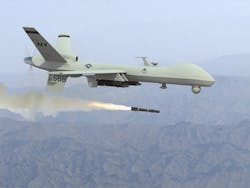Army and Lockheed Martin prepare for production of advanced laser-guided Hellfire missile
REDSTONE ARSENAL, Ala., 10 April 2012. U.S. Army officials are working with Hellfire Systems LLC in Orlando, Fla., to prepare for production of one of the latest versions of the Hellfire missile, which is launched from helicopters, unmanned aerial vehicles (UAVs), ground vehicles, and fixed sites against armored combat vehicles and other high-value targets.
The Army awarded Hellfire Systems an $8.7 million contract modification Monday for long lead parts for the AGM-114R Hellfire II Romeo RX missile, which will use a semi-active laser guidance system and an integrated blast fragmentation sleeve warhead to engage targets that previously needed several Hellfire variants.
Hellfire System is a venture of the Lockheed Martin Corp. Missiles and Fire Control segment in Orlando, Fla. At one time it involved the Boeing Defense, Space & Security segment in St. Louis, but Boeing has not been involved in Hellfire missile development and production for several years, Lockheed Martin officials say. The AGM-114R, or "Romeo," version of the Hellfire missile is to enter service late this year. The AGM-114R is to replace the AGM-114K, M, N, and P variants of the Hellfire missile.
Originally developed as an anti-tank missile for the Army's AH-64 Apache attack helicopter, the Hellfire missile has become one of the most versatile munitions in the U.S. arsenal. It can launch from fixed-wing aircraft and helicopters, UAVs such as the Predator and Reaper, as well as from surface vessels and land-based sites.
The AGM-114R will be guided by homing in on the reflected light of a laser designator. Other versions of the Hellfire are radar-guided fire-and-forget weapons. The Hellfire missile weighs 106 pounds, and has high-explosive variants designed to destroy tanks and other armored vehicles, and blast fragmentation versions designed to destroy trucks, antenna sites, concentrations of enemy troops, and other soft targets.
Development of the AGM-114R Hellfire missile became necessary after the Pentagon cancelled the Joint Common Missile (JCM) project, which was to replace Hellfire, as well as the AGM-65 Maverick air-to-ground missile.
The U.S. Army Aviation & Missile Command in Redstone Arsenal, Ala., is in charge of developing the Hellfire missile and its variants. This latest contract modification was awarded by the Army Contracting Command on behalf of Army Aviation & Missile Command.
For more information contact Lockheed Martin Missiles and Fire Control online at www.lockheedmartin.com/us/mfc, or the Army Aviation & Missile Command at www.army.mil/amcom.
Follow Military & Aerospace Electronics and Avionics Intelligence news updates on Twitter

